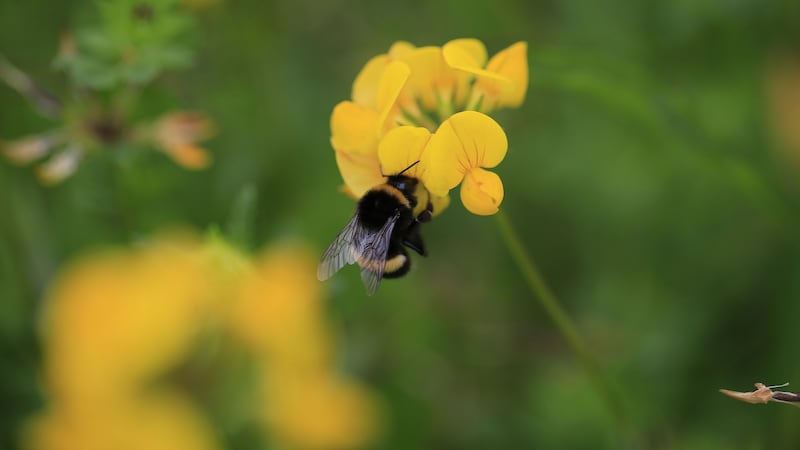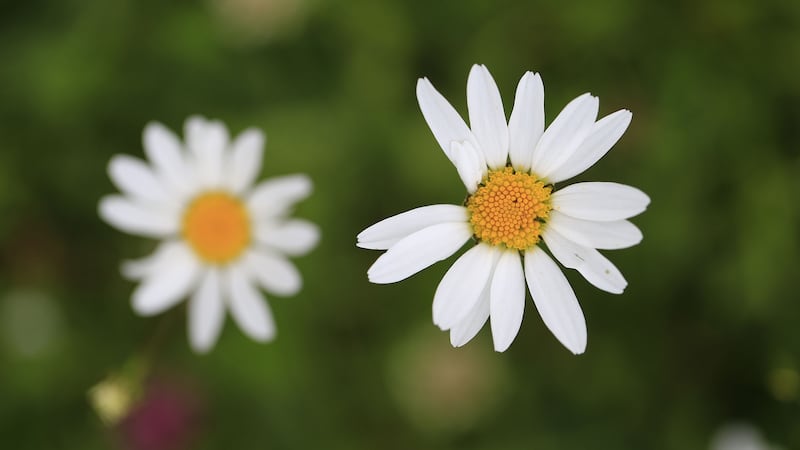The reawakening of people’s interest in planting for wildlife and the growing appreciation of wildflower meadows is one positive response to increased awareness of biodiversity loss. You can now see a variety of wildflowers on road margins, in sections of public parks, town gardens, golf courses and GAA pitches and even in private gardens.
Sandro Cafolla from Design by Nature has been selling native Irish wildflower seeds for more than 30 years and is one of Ireland’s most passionate experts on how to plant and maintain wildflower meadows. He hosts walks and talks in wildflower meadows for landscape and private gardeners, horticulturists, farmers, local authority staff and Tidy Towns volunteers who want to learn how to bring back the bounty of Irish wildflowers to the Irish landscape.
“What you are seeing here is a day in the life of an Irish wildflower meadow. Some will flower in April, others later and others right up until September, October and November,” he tells the group of almost 40 attendees at a walk and talk on the Prout Farm near Urlingford, Co Tipperary, in June.

Cafolla is keen to impress on us that the mix of wildflowers vary from season to season and site to site, depending on species, weather, soil, shade and cutting regime.
We are all enthralled by the beautiful gentle vista of wildflowers and grasses wafting in the wind in this four-hectare (10-acre) meadow of wildflowers grown for seed collection.
Some attendees remember fondly how as children they made daisy chains, carried “traces” of wild mushrooms on plantain stalks, sucked the juice from clover flowers or joked about how they loved butter when shiny buttercups reflected golden yellow under their chins.
“I would love to see more wildflowers back in the hedgerows. I feel our children – and grandchildren – are missing out on what we had as children,” says Imelda O’Riordan, one of those attending the master class in growing wildflowers. Everyone here is keen to understand how to encourage wildflowers to grow, aware that it’s not quite as simple as scattering wildflower seeds in a field or on a lawn.
Urban setting
Eoin Dullea, horticulturist with Waterford County Council, says that he and three other county council workers want to understand better how to manage wildflower meadows in a urban setting. “We have a wildflower meadow in Kilbarry Nature Park in Waterford city and in three locations in Dungarvan and last year we cut and baled hay and donated it to a local farmer,” he explains.
One of the keys to growing a wildflower meadow is to reduce the fertility of the soil as generally speaking the poorer the soil, the easier it is for wildflowers to grow. Clearing the ground of perennial weeds is another important task.
“To get rid of weeds, you need to deep plough so that you turn the top soil upside down and bury most of the weeds. By bringing their roots to the surface, you are weakening them. You might have to do this three or four times before you start sowing wildflowers,” says Cafolla.
It can take several years for some wildflowers to germinate and grow. And, it takes patience and effort to cut back docks, thistles and nettles so that wild grasses can grow in their place to allow the wildflowers to thrive.

“Selling Irish wildflower seeds to people is all about managing their expectations. Some people see very colourful pictures of wildflower meadows with cornflowers, poppies and marigolds but this won’t always be your experience when you grow them yourself . . . Meadows are not glossy, showy things. It can take five to eight years for some wildflowers to germinate from seed and come into flower,” says Cafolla, whose Design by Nature seeds are guaranteed for three years.
If planting wildflower seeds on a lawn, the grass must be cut and cut again until it’s so short that soil patches can be seen. The wildflowers can then be sown by hand on the top of lightly raked soil which is firm but crumbly on top. The seeds are then raked back into the soil with one single action.
I think we have to award plants rights in Ireland
Cafolla advises people to start on a small patch to see if they like what grows. “Different wildflowers will grow in different parts of the country depending on the soil but west of the Shannon, you won’t get pretty wildflowers like poppies or cornflowers.” Most wildflower seed bags have 15-25 species, a mix of annuals and perennials including poppies, cornflowers, cowslips, clover and oxeye daisies. A level teaspoon of seeds is required for each square metre.
Wildflowers can be sown from mid-March to late May or into July if it’s wet and then again in late August to September. “But if you want flowers in September – for a school garden for example, it’s best to sow in June. And you can cut a wildflower meadow at any time of the year and flowers will return,” says Cafolla.
Robert Prout, the farmer who is hosting the master class in growing a wildflower meadow is one of a number of farmers on whose land, Cafolla grows wildflowers for seed.
Prout explains that his interest in growing wildflowers sprung from his youthful dislike of mowing the lawn around his parents’ house. “So when I built my own house, I decided to have a wildflower meadow around it so I wouldn’t have to mow the grass. Then, in 2005, I decided to get 10 acres of permanent pastureland ready for growing wildflowers as a satellite grower for Sandro.”
He now prepares new plots for sowing which are then sown by Cafolla and his co-workers. Prout controls the weeds and harvests seeds by combine harvester after specific wildflowers have been harvested by hand. “I have about 5 per cent of my farm in wildflowers. To me, it’s giving a bit back to nature.”
Cafolla became passionate about Irish wildflowers from an early age. Working first as a landscape gardener and then growing Irish wildflowers to inform research at the Teagasc Oak Park Research Centre in Co Carlow, Cafolla began collecting plants from various parts of Ireland and building up a living gene bank, saving some rare Irish wildflowers from extinction and sending others abroad to help breed them back into the world’s crop.
“I’ve been selling wildflower seeds for over 30 years now and I’ve seen a steady growth of sales. Some people call me the flower fairy. I’m an activist and I believe that the importation of wildflowers – with their diseases and insect eggs – has been [part] of the destruction of Irish nature. In France, they have just awarded trees rights. In India, animals have rights. I think we have to award plants rights in Ireland,” he says.
Cafolla’s latest project is to enable schools and parks to grow and collect the seeds of native wildflowers as part of Ireland’s effort for the forthcoming UN Decade of Ecosystem Restoration. Watch this space.










